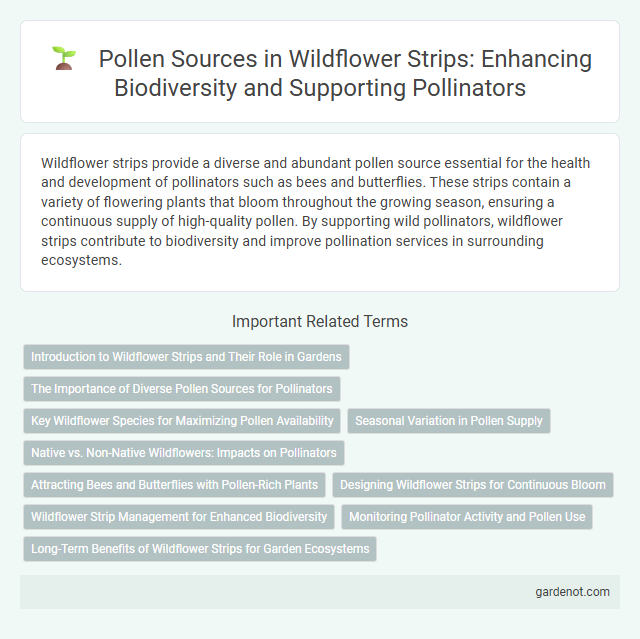Wildflower strips provide a diverse and abundant pollen source essential for the health and development of pollinators such as bees and butterflies. These strips contain a variety of flowering plants that bloom throughout the growing season, ensuring a continuous supply of high-quality pollen. By supporting wild pollinators, wildflower strips contribute to biodiversity and improve pollination services in surrounding ecosystems.
Introduction to Wildflower Strips and Their Role in Gardens
Wildflower strips serve as vital pollen sources, attracting diverse pollinators such as bees, butterflies, and hoverflies that enhance garden biodiversity. These strips typically consist of native flowering plants like coneflowers, black-eyed Susans, and milkweed, which bloom at staggered times to provide continuous pollen throughout the growing season. Incorporating wildflower strips into garden design supports pollinator health and boosts the productivity of surrounding plants by ensuring consistent pollen availability.
The Importance of Diverse Pollen Sources for Pollinators
Diverse pollen sources in wildflower strips provide essential nutrients that support the health and reproductive success of pollinators such as bees, butterflies, and hoverflies. A variety of pollen types ensures continuous floral availability throughout the growing season, reducing nutritional stress and promoting robust pollinator populations. Incorporating native wildflowers with different blooming periods maximizes pollen diversity, enhancing pollinator resilience and ecosystem stability.
Key Wildflower Species for Maximizing Pollen Availability
Key wildflower species such as Echinacea purpurea, Asclepias tuberosa, and Solidago canadensis provide high pollen availability essential for pollinator health. These species bloom at staggered intervals from early spring to late fall, ensuring continuous pollen sources throughout the growing season. Incorporating diverse native wildflowers enhances pollen quantity and quality, supporting a broad range of pollinators.
Seasonal Variation in Pollen Supply
Wildflower strips provide a diverse pollen source with significant seasonal variation, peaking in spring and early summer when many native wildflowers bloom. This temporal distribution supports pollinators throughout their active periods, ensuring continuous access to essential nutrients. Understanding the phenology of plant species within these strips is crucial for optimizing pollen availability across different seasons.
Native vs. Non-Native Wildflowers: Impacts on Pollinators
Native wildflowers provide essential pollen sources that are specifically adapted to support local pollinators, enhancing their foraging efficiency and reproductive success. Non-native wildflowers may offer abundant pollen but often lack the nutritional balance or compatibility required by native pollinator species, potentially disrupting local ecosystems. Establishing wildflower strips dominated by native species promotes biodiversity and sustains healthy pollinator populations critical for ecosystem resilience.
Attracting Bees and Butterflies with Pollen-Rich Plants
Wildflower strips planted with pollen-rich species such as coneflowers, black-eyed Susans, and bee balm provide essential foraging resources that attract bees and butterflies, supporting local pollinator populations. These plants not only supply abundant pollen but also offer continuous bloom periods, ensuring consistent food availability throughout the growing season. Integrating diverse native wildflowers enhances habitat quality and promotes biodiversity by sustaining pollinators crucial for ecosystem health and crop pollination.
Designing Wildflower Strips for Continuous Bloom
Designing wildflower strips for continuous bloom ensures a reliable pollen source by incorporating diverse native species with staggered flowering times. Selecting plants such as Black-eyed Susan (Rudbeckia hirta), Purple Coneflower (Echinacea purpurea), and Wild Bergamot (Monarda fistulosa) extends nectar availability from early spring through late fall. This strategic planting supports pollinators like bees and butterflies, enhancing ecosystem health and agricultural productivity.
Wildflower Strip Management for Enhanced Biodiversity
Wildflower strips serve as crucial pollen sources, supporting diverse pollinator populations by providing continuous floral resources throughout the growing season. Effective wildflower strip management involves selecting native plant species with staggered blooming periods to maximize pollen availability and sustain insect biodiversity. Regular monitoring and adaptive practices, such as controlled mowing and invasive species control, enhance habitat quality and promote robust ecosystem services.
Monitoring Pollinator Activity and Pollen Use
Wildflower strips provide a diverse pollen source essential for sustaining pollinator populations, enhancing biodiversity, and supporting ecosystem services. Monitoring pollinator activity in these strips reveals patterns of pollen collection, which informs plant species selection and management practices to optimize pollen availability. Effective pollen use by pollinators in wildflower strips contributes to improved crop pollination and promotes the health of native pollinator communities.
Long-Term Benefits of Wildflower Strips for Garden Ecosystems
Wildflower strips provide a rich pollen source that supports pollinator populations such as bees, butterflies, and hoverflies, enhancing biodiversity in garden ecosystems. The continuous bloom of diverse wildflower species ensures a steady supply of pollen throughout the growing season, promoting long-term pollination services and improving plant health. These benefits contribute to increased crop yields and ecological resilience, making wildflower strips a sustainable investment for garden ecosystems.
Pollen source Infographic

 gardenot.com
gardenot.com